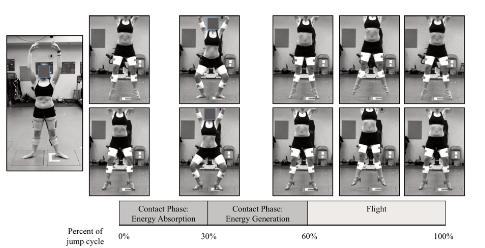Does dancing in heels hurt your knees? This may be why.
Author: Pamela Mikkelsen on behalf of the IADMS Promotion Committee
Dancers know that the shoes we wear impact how our bodies feel after dancing. I know that dancing full production shows in heels left my knees sore in ways that wearing flat shoes didn’t. Some of this soreness can be explained by differences in choreography demands but how much of the soreness could come down to the shoes? There is little research on how performing the same task in different shoes changes how much the leg joints and muscles work. In a recent study published in Medical Problems for Performing Artists, we examined the impact of wearing heeled shoes on a basic dance jump: sautés.
We found that wearing heels causes the knee joint and muscles to work more while the ankle works less even when the choreography is the same. As dancers, we know the body has a great ability to adapt and perform under different conditions and this is a good demonstration but we can use this new knowledge to decrease injury rates in dancers. For instance, choosing flat shoes instead of heels during long rehearsals may be a safer choice with regard to minimizing knee pain for a show that requires heeled shoes for performance. Also, the footwear choice of a production may be influenced by understanding the demands of the choreography with the production team deciding on a flatter shoe to promote knee health of the performers. This research also demonstrates one potential benefit to wearing heeled shoes with the use of “teacher shoes” for instructors that have ankle injuries like Achilles tendon pain. The slight heel height may decrease the demand on the ankle and redistribute it to the knee for improved tolerance to being on one’s feet all day. This study provides further evidence to consider footwear, and especially heeled shoes, for performance and rehearsal with regard to potential overuse injuries.
The research was done by analyzing the mechanics of each joint of the leg during the sautés. The individual joints of the leg must each produce energy in order to do a movement like a jump. The amount of energy produced to create movement is called work and the different joints will do different amounts of work for different movements. Our study looked at how much work the hip, knee, and ankle each performed doing repeated sautés in bare feet and when wearing heeled character shoes. We had ten female dancers participate at the Musculoskeletal Biomechanics Research Laboratory at the University of Southern California. We found that, when wearing heels, the work was significantly shifted toward the knee and away from the ankle. The ankle produced less energy while the knee produced more to do the same sauté.

The figure shows the phases of a sauté: Contact Phase, when the dancer is on the ground, and Flight, when the dancer is in the air. The Contact Phase can be broken into Energy Absorption (landing) where the leg joints do work to decelerate the body as it comes down and Energy Generation (take-off) where the leg joints do work to push the body upward. We found that the knee does more work than the ankle during both the landing and the take-off of a saute when wearing heels.
We hypothesized a few different reasons for the differences seen when wearing heels. When wearing heels, the foot is in more of a pointed position and the ankle can’t move as much as when barefoot. This may cause the dancer to use the knee more when wearing heels. Other reasons include the dancer’s perception of friction and feeling less stable in heels. The increase in knee demand indicates that footwear may contribute to knee injuries seen in dancers and should be considered when making choices during rehearsal and performance.
*****
The research was performed by me, Pamela Mikkelsen, PT, DPT, OCS; Danielle N Jarvis, PhD, ATC; and Kornelia Kulig, PT, PhD. I am a physical therapist that specializes in outpatient orthopedics in Los Angeles and an adjunct instructor of clinical physical therapy at the University of Southern California. In addition to working with the general orthopedic population, I work with dancers and have an interest in preventing injury this unique population. I worked as a professional dancer and teacher for over ten years and am excited to contribute to the scientific knowledge of this art form and help strive for safer practices.